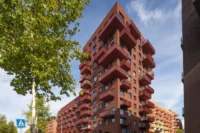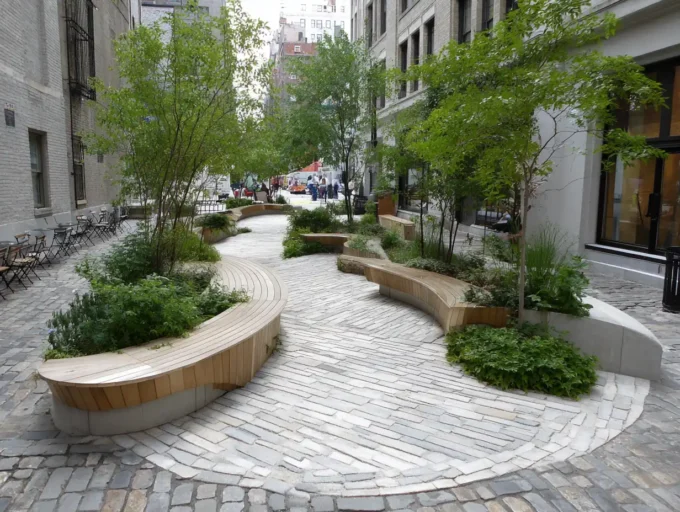In our bustling urban environments, green areas often take a backseat to concrete and steel. Yet, these pockets of nature play a crucial role in enhancing our quality of life. From parks and community gardens to tree-lined streets, green spaces offer us a breath of fresh air amid the chaos of city living.
Not only do they provide a sanctuary for relaxation and recreation, but they also contribute significantly to our mental and physical well-being. Research shows that spending time in green areas can reduce stress, boost mood, and even improve our overall health. As we explore the importance of these green oases, we’ll discover how they benefit our communities and help create a more sustainable urban landscape.

The Importance of Green Areas Within the City
Green areas within the city provide essential benefits for residents and the environment.

- Enhancing Air Quality: Green spaces filter pollutants and produce oxygen. Trees, shrubs, and plants effectively absorb carbon dioxide and other harmful gases, contributing to better air quality.
- Promoting Biodiversity: Urban green areas serve as habitats for various species. Parks and gardens attract birds, insects, and other wildlife, promoting ecological balance.
- Reducing Urban Heat: Green spaces help combat the urban heat island effect. Vegetation cools the environment through shade and evapotranspiration, leading to more comfortable city temperatures.
- Encouraging Physical Activity: Parks and recreational areas offer space for exercise and sports. Access to these facilities encourages active lifestyles, improving physical health across the community.
- Supporting Mental Health: Nature exposure positively impacts mental well-being. Studies show that time spent in green areas reduces feelings of anxiety and increases overall happiness.
- Fostering Community Interaction: Green spaces serve as communal gathering places. Parks and gardens encourage social interactions, enhancing community bonds and fostering a sense of belonging.
- Enhancing Property Values: Proximity to green areas often increases property values. Well-maintained parks and gardens attract potential buyers and renters, enhancing economic growth.
- Contributing to Water Management: Green spaces absorb rainwater, reducing urban flooding. They mitigate stormwater runoff, protecting city infrastructure and natural water systems.
Incorporating more green areas into our urban designs benefits both residents and the environment. Prioritizing these spaces contributes to healthier, happier city living.
Benefits of Green Areas
Green areas in urban settings provide essential benefits that enhance both the environment and public health. By integrating more greenery into our cities, we create vibrant, sustainable living spaces.

Environmental Impact
Green areas improve air quality by filtering pollutants and producing oxygen. Specifically, trees absorb carbon dioxide, contributing to lower greenhouse gas levels. Parks and gardens promote biodiversity by providing habitats for birds, insects, and other species, fostering ecological balance. Urban greenery also reduces the heat island effect, which occurs when cities become significantly warmer than surrounding rural areas. Vegetation cools the environment through shade and evapotranspiration, thereby decreasing the need for energy-intensive cooling systems. Moreover, green spaces assist in effective water management by absorbing rainwater and reducing stormwater runoff, mitigating flood risks.
Health and Wellbeing
Green areas significantly enhance mental and physical health. Spending time in parks, gardens, or natural environments decreases stress and anxiety, promoting mental clarity and emotional stability. Research shows that regular exposure to nature boosts mood and cognitive function while increasing feelings of happiness. Furthermore, green spaces encourage physical activity by providing safe environments for walking, jogging, or engaging in sports, which leads to improved cardiovascular health. Community gardens and parks also foster social interaction, enhancing community cohesion and reducing feelings of isolation, contributing to overall wellbeing.
Economic Advantages
Green areas in urban environments contribute significantly to economic benefits, enhancing property values and supporting local businesses.

Increased Property Values
Green spaces positively impact property values by creating attractive and desirable living environments. Properties near parks and green areas often sell for 10-20% more than those located farther away. Buyers prioritize homes that offer proximity to greenery due to the perceived benefits of living near such spaces. Studies also show that well-maintained parks and greenery can lead to quicker sales and higher rental rates, demonstrating that the presence of green areas translates directly into economic gain for homeowners and real estate markets.
Boosting Local Businesses
Green areas provide crucial support to local businesses by attracting foot traffic and encouraging community engagement. Parks and community gardens serve as popular gathering spots, drawing residents and visitors alike. Increased foot traffic leads to more potential customers for nearby shops, cafes, and restaurants, fostering a vibrant local economy. For example, businesses near green spaces often see a rise in sales by up to 20% when nearby parks offer amenities and host events. By fostering a sense of community and providing leisure opportunities, green areas strengthen the local business ecosystem.
Social Aspects
Green areas play a crucial role in fostering social connections within urban environments. They serve as communal hubs where residents can engage, relax, and build relationships, ultimately enhancing the quality of life in cities.

Community Engagement
Community engagement thrives in green spaces. Parks and gardens provide venues for local events, gatherings, and workshops, strengthening social bonds. By hosting activities like farmers’ markets, outdoor concerts, and art exhibitions, these areas encourage interaction among residents, create a sense of belonging, and promote civic pride. Studies show communities with accessible green spaces experience increased social cohesion, reducing isolation and fostering a supportive network among residents.
Recreational Opportunities
Recreational opportunities abound in urban green areas. These spaces allow for diverse activities such as jogging, cycling, picnicking, and playing sports. Parks equipped with playgrounds and fitness stations cater to individuals of all ages, promoting active lifestyles. Evidence indicates that easy access to recreational facilities in green areas boosts physical activity levels, which leads to improved health outcomes. By encouraging outdoor exercise and leisure, these spaces contribute significantly to the overall well-being of community members.
Challenges in Maintaining Green Spaces
Maintaining green spaces in urban environments presents several challenges.

Funding Limitations
Funding shortages hinder the upkeep of parks and community gardens. We face difficulties allocating sufficient budgets for routine maintenance, landscaping, and necessary repairs. Limited resources can lead to neglected areas and reduced public engagement.
Urban Development Pressures
Urban development pressures often threaten green spaces. As cities expand, developers may prioritize construction over preservation. We must balance growth with the need to protect and enhance our green areas.
Climate Change Impacts
Climate change adversely affects the health of urban green spaces. Increasing temperatures and unpredictable weather patterns can stress plants and alter ecosystems. We can support initiatives that promote climate-resilient landscaping practices to mitigate these impacts.
Pollution and Environmental Stressors
Pollution poses a significant threat to the health of urban green areas. Exposure to high levels of air and soil pollutants can diminish plant vitality and biodiversity. We should advocate for stricter regulations to limit emissions and protect our greenery.
Community Involvement and Awareness
Community involvement plays a crucial role in maintaining green spaces. Low awareness and participation can result in vandalism and littering, detracting from the beauty and usability of these areas. We can foster community engagement through outreach and educational programs.
Pest and Disease Management
Pest and disease management remains a persistent challenge for urban greenery. Infestations can quickly spread and affect a variety of plant species. We must implement effective monitoring and control strategies to safeguard our green spaces.
Climate Adaptation Strategies
We must develop adaptive management strategies to combat the fluctuating climates affecting our urban landscapes. Implementing diversity in plant selection can enhance resilience and ensure our green areas thrive amid changing conditions.
By addressing these challenges head-on, we can ensure our urban green spaces remain vital components of our cities, benefiting the environment and the community alike.
Conclusion
We acknowledge the essential role green areas play within urban environments. As cities continue to expand, integrating parks, community gardens, and tree-lined streets becomes increasingly vital. These spaces not only enhance mental and physical well-being but also improve air quality, promote biodiversity, and provide vital shade. Urban green spaces are instrumental in fostering community interaction while supporting local economies.
Research consistently demonstrates that proximity to green areas correlates with reduced stress levels and improved overall health. We recognize that the diversity of activities available in these spaces promotes active lifestyles, directly benefiting community health outcomes. Additionally, community gardens and parks cultivate social connections, creating vibrant hubs for engagement and civic pride.
While challenges exist, including funding limitations and urban development pressures, our commitment to advocating for these vital spaces remains unwavering. Community involvement is crucial in combating issues like vandalism and littering, ensuring these areas thrive. By focusing on educational programs and effective management strategies, we can enhance the resilience of urban greenery.
We emphasize the importance of prioritizing green spaces in urban planning. Incorporating more greenery not only enriches our environment but also enhances the quality of life for city residents, fostering healthier, happier communities.
- benefits of urban parks
- city green spaces
- city green zones
- city parks benefits
- enhancing urban life with nature
- environmental benefits of urban green spaces
- green infrastructure urban planning
- green spaces and mental health
- Green Urban Living
- importance of green areas
- importance of nature in cities
- improving urban environments
- sustainable urban design
- urban areas and green environment
- urban biodiversity benefits
- urban green areas impact
- urban green spaces benefits
- urban landscaping benefits
- urban nature spaces
- urban wellbeing green spaces
















Leave a comment